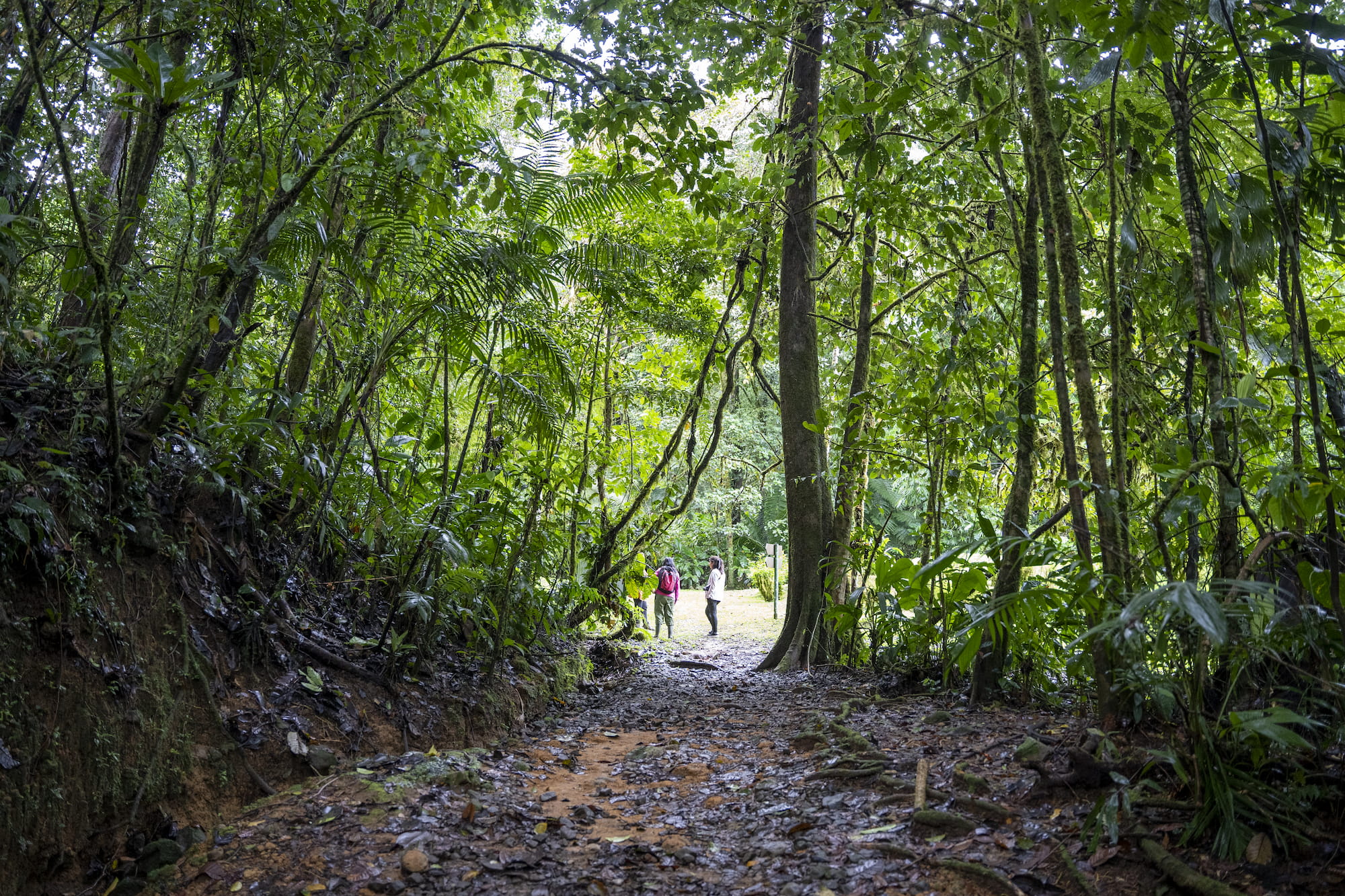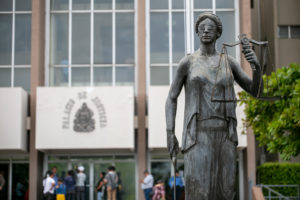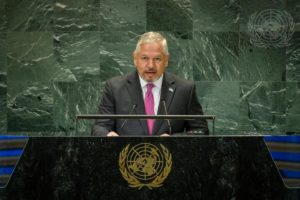In Honduras, climate change affects 90% of the population on a daily basis, underscoring the need for real solutions from the authorities. Journalists for the Planet (PxP) and the Organization for Tropical Studies (OTS) are joining forces to provide journalists in the region with tools to cover stories on ecosystem restoration and climate change.
Text: María Celeste Maradiaga
Photographs: Nina Cordero
Translated by Ann Deslandes
Urpi Castañeda, a biologist with the Organization for Tropical Studies (OTS) in Costa Rica, explains the organization’s perspective.
“We see how everything has a dynamic,” she says.“Everything from the leaf that falls, how it works to form the soil, the seeds… We pay attention to these details and, with all this, we build solutions.”
Castañeda says that in the region of Central America alone, there are 948 protected areas, totaling 245,857 kilometers. Within this area, about 39% is made up of indigenous and Afro-descendant territory. This is important because it affirms the intrinsic relationship between indigenous and Afro-descendant territories and protected areas.
Honduras has 91 protected areas, including 21 national parks. In these national parks, there are 5 active hydroelectricity or mining concessions that threaten the areas. One of these is the businessman Lenir Pérez’s mining project, for which activists defending the Guapinol River have been criminalized.
On February 28, 2022, the Ministry of Natural Resources and Environment (Secretaría de Recursos Naturales y Ambiente, SERNA), declared Honduras a territory free of open-pit mining. Sometime later, the Minister of Environment, Lucky Medina argued that more studies needed to be done on each of the mining projects to realize this commitment.
Although President Xiomara Castro has expressed her support for Guapinol’s defenders, the position of Minister Medina and SERNA has put the defenders of the Guapinol River and environmentalists in the country on alert.
READ: Despite new Honduran government, big business is still destroying the environment
In 2010, after a tireless struggle against open-pit mining by Costa Rican environmentalists along with 90% of the population, the Costa Rican Legislative Assembly unanimously approved a ban on open-pit metallic mining and the use of toxic substances such as cyanide and mercury in mining activities, making Costa Rica the first country in Latin America to do so. This put an end to the mining projects being pushed through at that time, allowing artisanal [small-scale] miners to phase out using the chemicals over an eight-year period.
At a workshop held in Costa Rica on September 9, journalists from Guatemala, El Salvador, Nicaragua, Costa Rica, Puerto Rico, and Honduras took a tour of the Wilson Botanical Garden at the Las Cruces Biological Station in the province of Puntarenas, surrounded by various species of plants and the songs of different types of birds. The workshop affirmed the indispensable role of nature in the preservation of a healthy and habitable environment for humans — above all, an environment created and self-regulated through biodiversity that is increasingly threatened by the climate emergency. Biologists from the region also participated in this workshop.
Beyond the important work of learning about environmental issues, the workshop aimed to motivate journalists to increase journalistic coverage of environmental and climate emergency issues and transmit scientific concepts in a simple way to the population. This is a way of democratizing knowledge and demanding answers and solutions from authorities.
The OTS is a non-profit consortium that brings together more than 50 research institutions located in the Americas, South Africa and Australia. In operation since 1963, it welcomes researchers from around the world for the purpose of strengthening education and research in tropical biology.
In Costa Rica, OTS has three research stations: La Selva, located in Sarapiqui; Las Cruces, in Coto Brus; and Palo Verde, located in Bagaces. On this tour, we visited the first two, the provinces of Heredia and Puntarenas.
Castañeda explains that through nature-based solutions it is possible to protect nature, and sustainably manage and restore natural and modified ecosystems to address societal challenges in an effective and adaptive manner. This simultaneously provides benefits for human well-being and biodiversity.
Restoration, sustainable land management, and protection of different ecosystems are key activities in developing the rules and principles of nature conservation, along with transparency and community participation to provide social benefits in a fair and equitable way – above all maintaining biological and cultural diversity and ecosystem capacity.
These principles are fundamental when it comes to nature-based solutions, says Castañeda.
Companies claim their “commitment to the environment by implementing nature-based solutions,” while they also set up in protected areas, threaten environmental defenders and destroy the existing biodiversity in these spaces, she notes.
Known as the ‘Central American Amazon’ due to its biodiversity and cultural richness, the Moskitia region is located in eastern Honduras. It includes the Río Plátano Biosphere, declared a World Heritage Site in 1980, and the Tawahka Biosphere Reserve, which includes the municipality of Gracias a Dios and Olancho. The Moskitia is also home to the Coco or Segovia River, the Patuca River, and the Plátano River.
However, both these natural reserves and the Miskito and Tawahka indigenous people have been threatened by the extensive cattle ranching that is gradually extending into these areas and the threat of a highway that is getting closer and closer to the core zone of the Río Plátano Biosphere. The Miskitos have also been displaced from their communities through drug trafficking activity and the arrival of cattle ranchers. Their territory can only be accessed by air or sea.
READ: Honduran gov’t breaking promises made to Indigenous people and environmental activists
Restoration is more than planting trees
Urpi Castañeda and fellow OTS biologist Pablo Ruíz agree that ecological restoration is usually understood as simply planting trees in deforested areas. It goes beyond that, they say; for them, it is important to question what we are going to restore and why, and, after that, identify ‘reference forests’ to create an ecosystem that is approaching the ideal.
Within this, there are two types of recovery or rehabilitation of an area that has been affected by natural or man-made practices: passive and assisted. The passive type deals with the recovery of the area on its own over time, while the assisted type – applied where the soil cannot regenerate on its own – requires the planting of trees and other native herbaceous species, the provision of barriers to prevent access by animals such as cattle, and the creation of wildlife refuges.
In Honduras, the Forest Conservation Institute (El Instituto de Conservación Florestal – ICF) has implemented the ‘Watershed Restoration and Protection Program’ to restore degraded and deforested land throughout the country, via “the production of seedlings, reforestation, promoting the incorporation of trees in productive agricultural and pastoral systems, and evaluation of forest areas in the process of regeneration.”
The ICF says that by 2030, 1.3 million hectares of degraded and deforested land will have been restored throughout Honduras.
Ecosystem restoration involves a number of services that in the long run are beneficial for society; services such as cultural, sustainable, and regulatory systems that ecosystems usually provide. This was clear in Costa Rica which in 1987 went from an original 75% forest cover in the whole country to an alarming 21%, while thanks to restoration activity forest cover increased to 51%.
According to ICF estimates, more than 1,656,903 hectares of forest have been lost to deforestation in the last decade in Honduras. Among the causes is the expansion of the agricultural frontier, land tenure, forest fires and cross-border smuggling. ICF also adds that a lack of forestry policies means that deforestation goes unnoticed – further, so far, there are no known ecosystem restoration initiatives promoted by government authorities in the country.
There are three types of forests in Honduras: broadleaf forest (humid, dry forest and mangroves), with approximately 3.91 million hectares, pine forest (dense pine and sparse pine) with 2.53 million hectares and mixed forest (oak and pine) with 0.16 million hectares.
It should be noted that this does not only apply to terrestrial ecosystems. Rita Sellares, a marine biologist and director of the Dominican Foundation for Marine Studies (Fundación Dominicana por Estudios Marinos – FUNDEMAR), works on the conservation and restoration of reefs through the asexual reproduction of a coral species. This project has been so successful that it has been spreading in the Dominican Republic and worldwide.
In 2021, through Coralmania, a project aimed at the protection and restoration of underwater life and the oceans in which Costa Rica, the Dominican Republic and Honduras participate, 2,579 coral fragments were transplanted; in the case of Honduras specifically, 1,800 coral fragments were transplanted. One of the foundations promoting this and other activities to restore marine ecosystems since 2016 is Fundemar.
Rita notes that FUNDEMAR’s work would not be possible without the support of fishermen in the Dominican Republic, who have taken it upon themselves to be guardians of coral reefs by understanding the importance they have in regulating the marine ecosystem. In addition, the marine biologist has a team committed to the environment, most of whom are young people studying the various measures taken in the preservation of the reefs.
In early 2021, Antal Borkson, director of the Tela Marine Research Center, warned about the Stony Coral Tissue Loss Disease and how it threatened to kill between 50% and 70% of the entire coral reef in Roatan, Bay Islands, in the next two years. It should be noted that the coral reefs of the Caribbean coast of Honduras are part of the largest Mesoamerican Barrier Reef system in the world.
Intersectionality in environmental journalism
According to the 2016 study Climate change in Honduras: children at risk, “climate change is part of the present of Honduran society and affects 90% of the population on a daily basis, although with different degrees and intensity”, meaning that, even taking into account people’s ages, along with other factors such as ethnicity, gender, level of education, economic income and others, children continue to be the age group most vulnerable to the effects of climate change in the country.
This is due to the lack of opportunities for children in the interior of the country to access education, a comprehensive health system, and clean water in their communities. At the same time, children are facing the impacts of climate change through reduced food production and related jobs, thus increasing food and nutritional insecurity.
The climate crisis is the emergency caused by the rate at which global temperatures have been increasing in recent decades, mainly as a result of human activity, but above all, of large industries. We are currently experiencing the effects of climate change produced by the first coal that was burned in the Industrial Revolution, in approximately 1850, and, in addition, according to the United Nations, the concentrations of greenhouse gases, generated by the burning of fossil fuels such as oil, coal, and gas, are at their highest level in the last 2 million years.
Pilar Assefh, a journalist specializing in climate change law, and Michelle Soto of Journalists for the Planet (PxP) consider that it is essential for the media to publicize the impacts of the planetary crisis from an intersectional perspective, where climate change is not only an environmental issue but also a legal, economic, social, human rights, gender issue that intersects with absolutely everything that makes up our lives.
In 2021, the Honduran people took to the streets to protest against the Employment and Economic Development Zones (Las Zonas de Empleo y Desarrollo Económico – ZEDE), zones that were subject to their own legislation while being completely outside Honduran territory. In addition, indigenous peoples protested against the ZEDEs because one of them, the ZEDE Prospera, is located in the department of Islas de la Bahía in northern Honduras, one of the departments with the greatest biodiversity and coral reef in the country.
In May 2022, the National Congress repealed the ZEDE Organic Law, and although this now obliges the existing ZEDEs in the country (Próspera, in Islas de la Bahía; Ciudad Morazán, in Choloma, department of Cortés; and Orquídea, in the department of Choluteca) to submit to one of the existing special regimes, Zede Próspera continues to operate normally.
Regarding the defense of the environment, Michelle Soto reflects on the harassment and assassinations of environmental defenders and activists in Latin America, and how this could worsen with the installation of mining projects and the exploitation of fossil fuels.
For her struggle in defense of the Rio Blanco and for opposing the installation of the Agua Zarca hydroelectric dam, Berta Cáceres, an internationally recognized indigenous leader and environmentalist, was assassinated in March 2016.
David Castillo, one of the perpetrators of her murder, has been convicted as a co-perpetrator of Berta’s murder and sentenced to 22 years in prison, however, the other people who participated in the crime have not been convicted, and the Agua Zarca project has not been canceled, only halted.
Michelle emphasizes the need to ratify the Escazú Agreement, Central American and Caribbean, which deals with the defense of environmental activists and strengthens their security.
As of August 2022, the Office of the United Nations High Commissioner for Human Rights in Honduras has recorded 44 attacks on defenders of land, territory, and the environment; of these people, at least 51 are indigenous people and 9 are Afro-Honduran.
In her Government Plan, President Xiomara Castro promised to act in favor of environmental protection, implementing a climate change adaptation and mitigation program. This program promises, in line with regional agreements, to “ensure recycling strategies for solid materials, the reduction of air, water, and soil pollution, the monitoring of the carbon footprint of our industry, and the prohibition of importing toxic waste”.
However, to date, the strategies that will be employed to bring these initiatives to reality are unknown.
Regarding the Escazú Agreement, Minister of Environment, Lucky Medina, expressed last September 8 that the Government will not have to be forced to adhere to the Agreement, since the Government is already working in favor of climate justice with a robust budget dedicated to these issues and with President Xiomara Castro’s support for environmental defenders.
Guapinol environmentalists have questioned President Xiomara Castro’s support for environmental activists. Juana Ramona Zúniga, environmental activist of the Guapinol River region has been clear on her position with the government: “In the first days of government, she said [President Castro] that the mines were to be canceled in Honduras, but from words to deeds nothing has happened, here the mines keep operating”.
At the workshop, the environmental journalists also considered the importance of telling stories that are close to our reality. An example is an analogy of the polar bear on an ice cube to illustrate the climate crisis, something that surely makes us sad, but that has nothing to do with the climate reality we live in Latin American countries. In addition, they pointed out that in environmental issues, journalistic work extends to being translators of many texts that are originally in English or other languages, something that limits the knowledge or understanding of different phenomena.
“The topic of climate change involves a lot of information in English, so we not only have to tell this story and be translators, but also be double translators, because we have to translate science, biology, the different branches of knowledge and many other things,” says Michelle Soto, stressing the importance of producing information and focusing it on our Central American reality.



















